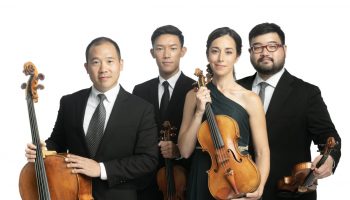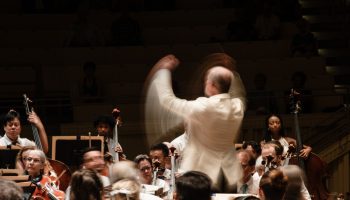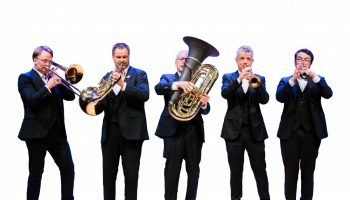Liz Delillo & Gabriel Weber
Staff Writers

In a triumphant collaboration on a rarely done program, the Music School Festival Orchestra, Chautauqua Opera Conservatory and the School of Dance unite for the sorrowful tale of La Vida Breve — “The Brief Life” — at 8:15 p.m. tonight in the Amphitheater under the baton of School of Music Artistic Director Timothy Muffitt.
With music written by Manuel de Falla and libretto by Carlos Fernández Shaw, La Vida Breve was composed in 1905, but not performed until 1913 due to a series of moves and revisions by de Falla. He was a Spanish composer, influenced by late Romantic music, who utilized kaleidoscopic colors that really enhanced the dramatic flow of the opera, Muffitt said.
“The opera itself is not done very often — a lot of times, people will extract certain areas from the opera, or they will extract the dance segments from the opera, but you don’t often have a chance to see this one done start-to-finish and in completion,” said Opera Conservatory Director Jonathan Beyer.
Bonnefoux McBride Artistic Director of Chautauqua School of Dance Sasha Janes hadn’t heard the music before, and is already considering the creation of a full-length ballet one day.
“There’s all these wonderful accents and intonations in the music that I try to pull out as much as I can,” Janes said. “It’s always really lovely when you find new music because, as a choreographer, you’re on a constant search for different new and exciting music.”
La Vida Breve details the love affair between a young girl named Salud and an upper-class youth named Paco — until he abandons her to marry someone richer, Carmela. At Paco and Carmela’s wedding, Salud collapses dead at his feet. While the overall tone is tragic, there are notable moments of relief with two full-throated Spanish dances.
“It was something great because it utilizes all of the orchestra. In certain operas, you don’t require a full orchestra, but this one requires harps and percussion — and so all of the students in the festival orchestra will be able to play this piece,” Beyer said. “I am especially excited because then it also means we’re collaborating with the dance department for the two big dance excerpts that happen within the opera.”
Interdisciplinary performing poses specific challenges to all artforms involved. Second-year MSFO student violinist Maxwell Fairman finds that there is a balance to be held between the dancers and singers.
“When we play opera music, it’s more about following the singers. So that means that if the singers want to take time somewhere, or if they want to push forward, then we need to be able to follow them for that,” Fairman said. “But with dancers, it’s more about keeping consistent tempos that the dancers can easily follow.”
While such a feat poses various obstacles, the payoff is immense.
“Whenever you’re playing purely instrumental music, if you want there to be some sort of story or imagery, you have to imagine all that yourself,” Fairman said. “When you’re collaborating with opera or dance, you can really see these stories come to life.”
For Beyer, the collaboration brings the kind of energy that elevates the performance as a whole.
“There’s so much energy in this piece, and there’s energy in having that big of an orchestra, and there’s energy to having dancers,” Beyer said. “This kind of singing is big and dramatic and exciting, so I think it’s going to be a very high-energy evening.”
Since the three separate schools remain incredibly busy, scheduling rehearsals all together is a true beast; the dancers are pushing seven days a week of practice without a break. However, the unique opportunity to collaborate across forms is highly coveted, Janes said, especially because the different expressions can be so siloed.
“The chance that this young group of artists gets to perform with live music, and now both singers and orchestra, is something that they’ll remember for the rest of their careers,” Janes said. “As we look ahead to the art scene in general, those things are going to become more of a rarity just because of the cost factor. They’re really blessed to have this opportunity. This is definitely the only dance program in the country where they get an opportunity like this to perform with an orchestra and singers.”
Muffitt finds that the exposure to the professional possibilities for these young artists opens up new potential avenues.
“It’s an extraordinary privilege and when we work with the dancers, that too is a different way of playing. That experience gets stashed away in the students’ musical memory — who knows when they might use what they’ve learned here to inform how they’re playing a sonata or in a string quartet, or something that’s purely instrumental,” Muffitt said.
Janes choreographed the piece for eight dancers from the Pre-Professional division of the School of Dance by listening to the music and letting the dance manifest from his subconscious. The dancers will be more involved during the moments of relief, as opposed to the devastation experienced by Salud.
“It’s more physical than I thought it was going to be,” Janes said. “It’s rambunctious; there’s a little bit of humor in it, but it’s quite sexy and fun, and hopefully it’s in keeping with the story.”
The Opera Conservatory and MSFO have been able to have more rehearsals together than with the dancers, so Muffitt works quite closely with the singers in particular. For the first few rehearsals, Muffitt does very little conducting to hear where their vocal comfort zone is and finds that those limitations enhance the human element of the music.
“A big part of what we do is respond to the individual singer, because singing is such an extraordinarily individual artform that we would make a mistake as instrumentalists to come into that scene with a too hard and fast vision of how things should roll,” Muffitt said. “There’s so much we do that is responding to the human being who is embodying the voice, but that’s also where the excitement comes in — making a musical and dramatic connection that’s tied to what this individual is bringing to the role.”
Conducting opera is different than conducting symphonies — a challenge that Muffitt appreciates and relishes.
“I love to conduct opera. The great operas, which the ones we do here are, are notable for the world that they create through the music, the drama and the use of voices,” Muffitt said. “The process of putting together an opera is as daunting as one might think, given how much is involved — you have singers, musicians and dancers — and you have a language that is different from the language we speak.”
Though opera singers are accustomed to singing in Romance languages, full Spanish opera productions are less common.
“The head coach on this piece is named Manuel Arellano, and he was also our Spanish diction coach, so it was very helpful to have a native speaker working on the language with all of the singers,” Beyer said. “… There is a great deal of vocal music written in Spanish, but we don’t often do the operas. For many (students), it will be their first experience singing in Spanish.”
Considering the different barriers to bringing a concert of this enormity, the night itself opens up reflection on the accomplishment itself.
“It grows your appreciation for the other artforms and all the work that they put into getting on stage and trying to understand their discipline and how it works,” Janes said. “To learn that and to find that appreciation for the different artforms is essential to having a greater understanding of how these collaborations can work in the future — they’re very worthwhile.”




